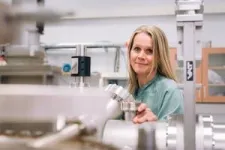(Press-News.org) Materials that are incredibly thin, only a few atoms thick, exhibit unique properties that make them appealing for energy storage, catalysis and water purification. Researchers at Linköping University, Sweden, have now developed a method that enables the synthesis of hundreds of new 2D materials. Their study has been published in the journal Science.
Since the discovery of graphene, the field of research in extremely thin materials, so-called 2D materials, has increased exponentially. The reason is that 2D materials have a large surface area in relation to their volume or weight. This gives rise to a range of physical phenomena and distinctive properties, such as good conductivity, high strength or heat resistance, making 2D materials of interest both within fundamental research and applications.
“In a film that’s only a millimetre thin, there can be millions of layers of the material. Between the layers there can be a lot of chemical reactions and thanks to this, 2D materials can be used for energy storage or for generating fuels, for example,” says Johanna Rosén, professor in Materials physics at Linköping University.
The largest family of 2D materials is called MXenes. MXenes are created from a three-dimensional parent material called a MAX phase. It consists of three different elements: M is a transition metal, A is an (A-group) element, and X is carbon or nitrogen. By removing the A element with acids (exfoliation), a two-dimensional material is created. Until now, MXenes has been the only material family created in this way.
The Linköping researchers have introduced a theoretical method for predicting other three-dimensional materials that may be suitable for conversion into 2D materials. They have also proved that the theoretical model is consistent with reality.
To succeed, the researchers used a three-step process. In the first step, they developed a theoretical model to predict which parent materials would be suitable. Using large-scale calculations at the National Supercomputer Centre, the researchers were able to identify 119 promising 3D materials from a database and a selection consisting of 66,643 materials.
The next step was to try to create the material in the lab.
“Out of 119 possible materials, we studied which ones had the chemical stability required and which materials were the best candidates. First, we had to synthesise the 3D material, which was a challenge in itself. Finally, we had a high-quality sample where we could exfoliate and etch away a specific atom layers using hydrofluoric acid,” says Jie Zhou, assistant professor at the Department of Physics, Chemistry and Biology.
The researchers removed yttrium (Y) from the parent material YRu2Si2, which resulted in the formation of two-dimensional Ru2SixOy.
But to confirm success in the lab, verification is necessary – step three. The researchers used the scanning transmission electron microscope Arwen at Linköping University. It can examine materials and their structures down at the atomic level. In Arwen it is also possible to investigate which atoms a material is made up of using spectroscopy.
“We were able to confirm that our theoretical model worked well, and that the resulting material consisted of the correct atoms. After exfoliation, images of the material resembled the pages of a book. It’s amazing that the theory could be put into practice, thereby expanding the concept of chemical exfoliation to more materials families than MXenes,” says Jonas Björk, associate professor at the division of Materials design.
The researchers’ discovery means that many more 2D materials with unique properties are within reach. These, in turn, can lay the foundation for a plethora of technological applications. The next step for the researchers is to explore more potential precursor materials and scale up the experiments. Johanna Rosén believes that future applications are almost endless.
“In general, 2D materials have shown great potential for an enormous number of applications. You can imagine capturing carbon dioxide or purifying water, for example. Now it’s about scaling up the synthesis and doing it in a sustainable way,” says Johanna Rosén.
END
A new world of 2D material is opening up
2024-03-14
ELSE PRESS RELEASES FROM THIS DATE:
Discovered: Cellulose-degrading gut bacteria in the human gut, although at lower levels in industrialized countries
2024-03-14
Previously undescribed human gut bacteria that aid in the digestion of plant cellulose are scarce in urban societies but abundant in ancient and hunter-gatherer microbiomes, according to a new study. The findings provide insight into the poorly understood cellulosome-producing bacteria that inhabit the human gut and their response to modern urban diets and lifestyles. Like all mammals, humans rely on the gut microbiome to digest cellulose – the main component of plant fiber and a common element in diets that include plant-based material. Fermentation of dietary fiber via cellulosome-producing ...
Direct-to-consumer microbiome testing lacks regulation and clinical validity
2024-03-14
In a Policy Forum, Diane Hoffman and colleagues argue that direct-to-consumer (DTC) microbiome tests lack analytical and clinical validity and require more federal regulation to prevent consumer harm. A growing body of research has suggested the potential for improving human health by better understanding the microbiome, leading to the emergence of a global industry selling DTC microbiome services. However, despite its impact on the lifestyle health and wellness market, regulation of the DTC microbiome testing industry has been virtually ignored. According to Hoffman et al., these companies’ claims of having ...
New approach to plastic production, under more sustainable conditions
2024-03-14
Researchers have developed a more sustainable method to do the work required to make plastics that are comparable to widely used low-density polyethylene (LDPE) plastics. They say their method is industrially viable. LDPE is a soft, flexible, and lightweight plastic material that is widely used in a variety of commercial applications, including plastic films, bottles and other pliable products. LDPE’s unique properties are derived from its tree-branch-like molecular structure, bestowing flexibility. The material is also ductile due to its lower crystallinity. These properties set it apart from other, more linear varieties of polyethylene. ...
A telluride-free way to improve the performance of thermoelectric systems
2024-03-14
Researchers report they have boosted the performance of a thermoelectric device using an approach that doesn’t require tellurium. The findings reveal a path toward more efficient and sustainable commercial applications of thermoelectric cooling based on Earth-abundant compounds. Efficient and sustainable cooling is crucial to modern living, particularly in our warming world. However, current cooling strategies require substantial energy, which can exacerbate anthropogenic climate impacts. Thermoelectric cooling is an attractive solid-state heat-pump technology that could reduce energy consumption ...
University of Maryland, Baltimore researchers call for regulation of direct-to-consumer microbiome tests
2024-03-14
BALTIMORE, March 14, 2024: Scientific research has linked a person’s microbiome to everything from gut and mental health to immunity and predisposition to cancer. This research comes at a time when there is a burgeoning interest in wellness and alternative medicine, which has fueled consumers’ curiosity about the composition of their own microbiomes.
This curiosity has led to a growing demand for direct-to-consumer (DTC) microbiome testing services. While the companies marketing these services claim to tell customers whether their microbiomes (gut, vaginal, skin…) are “healthy,” ...
Training dairy cows with positive reinforcement can turn otherwise stressful events into play
2024-03-14
Philadelphia, March 14, 2024 – Dairy cows receive a huge amount of care during their lives on a farm, but procedures, especially restraining during procedures, can be stressful for some animals. Positive reinforcement training—or training with a reward to achieve a desired behavior—has shown promise to reduce this fear in other species. In a recent study in the Journal of Dairy Science, published by the American Dairy Science Association and Elsevier, a team of researchers set out to understand whether ...
Information overload is a personal and societal danger
2024-03-14
We are all aware of the dangers of pollution to our air, water, and earth. In a letter recently published in Nature Human Behavior, scientists are advocating for the recognition and mitigation of another type of environmental pollution that poses equivalent personal and societal dangers: information overload.
With the internet at our fingertips with smartphones, we are exposed to an unprecedented amount of data far beyond our ability to process. The result is an inability to evaluate information and make decisions. Further, it can lead us to limit our social activities, feel unsatisfied with ...
Study: How home food availability affects young children’s nutrient intake
2024-03-14
URBANA, Ill. – Early childhood is an important time for learning about nutrition and establishing healthy eating behaviors. Young children rely on parents to provide food options, and the availability of food in the home affects their dietary choices. A new study from the University of Illinois Urbana-Champaign looks at changes in home food availability and nutrient intake for children from 2 to 4 years old.
“It's important to understand how the environments that children are in can influence their diet and nutrition. What types of foods and beverages are available in the home, and how accessible ...
A pioneering way to target the culprit behind a deadly liver cancer
2024-03-14
Cell division is the generative spark of nearly every lifeform on Earth. But if healthy growth goes unchecked, cell division can turn lethal, overwhelming the organism. Such is the case with so-called oncogenes. When altered by a mutation, these growth-moderating genes go haywire, producing a geyser of cancer cells as a result. Oncogenes are also insidiously adept at generating tumors that over time become genetically “independent” from their origin, so it has been exceedingly difficult for scientists to shut down their replication ...
Clay Wright receives MIRA funding to create new molecular tools
2024-03-14
Clay Wright, assistant professor in the College of Agriculture and Life Sciences’ Department of Biological Systems Engineering, was awarded a prestigious Maximizing Investigators' Research Award (MIRA) from the National Institute of General Medical Sciences, part of the National Institutes of Health.
The funding is aimed at providing the investigator, versus a specific project, enhanced stability and flexibility for further discovery, enhancing scientific productivity and the chances for significant breakthroughs outside the initial scope of the project.
This recognition supports Wright's innovative work in understanding ...





